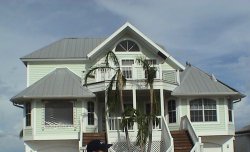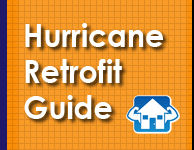|

|
Despite losing some windows and suffering roof damage, this wood frame home stood up well to Hurricane Charley
(click image for larger version) |
|
Well designed and well built wood frame homes, built to the latest building code provisions performed very well structurally in the highest hurricane winds to strike the US since hurricane Andrew. That was Hurricane Charley in 2004 and it clearly demonstrated that both wood frame and masonry homes built to the latest codes did well, at least structurally. The reason the latest codes do well is that they require the structure to have a continuous load path that directs wind loads applied to the roof and walls down through the structural system to the foundation. Key requirements for this load path include keeping the roof structure intact and connected to the walls and keeping the walls connected together and to the foundations.
Evaluating and Improving Continuous Load Paths in Wood Frame Walls:
There are several sets of load path elements and connections that need to be evaluated and possibly retrofitted to upgrade the walls and their connections so that they more closely match what is being required in the latest building codes. They are:
1. Wood Frame Roof-to-Wall Connections, where wind forces acting in different directions relative to the plane of the wall have to be transmitted between the roof structure and the wall structure. These wind forces include:
- Upward or downward forces generated by the wind acting on the roof surfaces.
- Horizontal forces arising from wind pressures applied to other walls that are transmitted to the wall in question by the roof structure and diaphragm action of the roof sheathing.
- Wind forces applied to the wall in question that would cause the top of the wall to move inward or outward if it were not connected to the roof structure.
2. Load Paths through the Wood Frame Walls, where the forces applied at the top of the wall are actually transmitted through the wall to its base. The strength of a particular load path depends on a lot of factors including wall construction details and alignment of the connections.
3. Wood Frame Wall-to-Floor Connections, where the forces transmitted through the wall to its base are transferred to the floor structure below or possibly to the foundation of the home.
4. The Connections Across Floors, where the forces transmitted to the bottom of one wall are transferred through or past the floor structure to the top of the wall below.
Back to Main Wall Page
|

